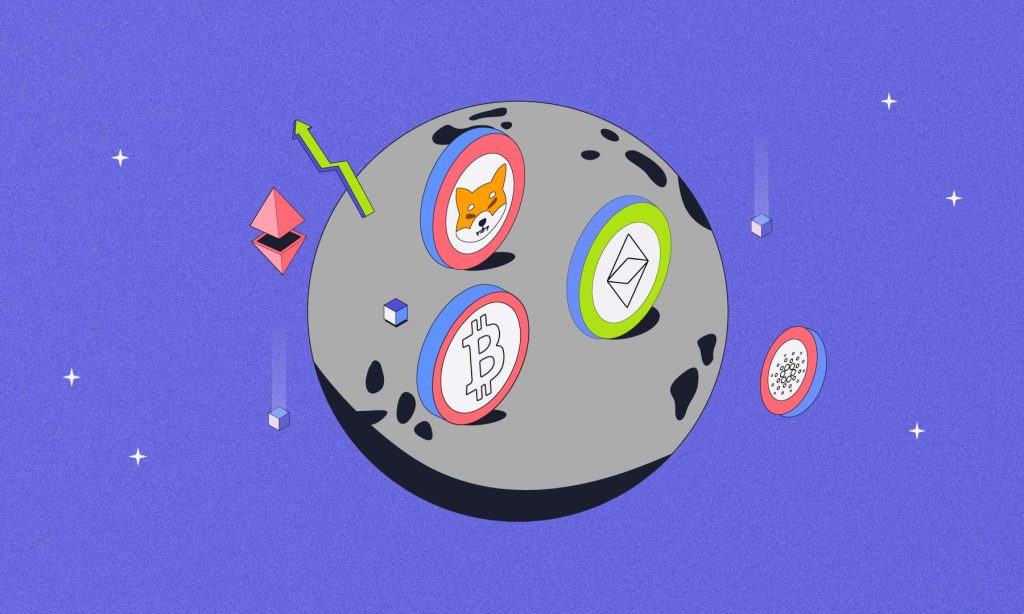The phrase “mooning,” widely used as a verb, refers to a crypto witnessing a major upward market trend. “To the moon” refers to the firm belief that the price of a specific cryptocurrency will rise substantially shortly.
Understanding the crypto slang “To the Moon”
Investors who anticipate significant growth in the value of their crypto or another asset will say, “to the moon.” The phrase is an allusion to terms like “sky-high valuation,” “soaring pricing,” and the like because of how high in the sky the moon is.
Investors occasionally use terms like “mooning” and rocket ship emojis on social media platforms to highlight the success of a crypto or a stock.
The significance and origin of the phrase
Like many other specialized professions, the nascent crypto sector is known for several jargon and slang expressions. Although the phrase “to the moon” is not unique to the blockchain industry, the expression is common in the crypto world, especially among investors and traders.
It’s crucial to remember that many crypto enthusiasts and influencers use the phrase to persuade others through social media that a specific coin or token would soar to the moon.
However, most of them are just looking out for themselves, that is, trying to influence the markets to favor their assets. Traders, buyers, and even the public at large grew thrilled about the growth in the value of crypto and the value of Bitcoin (moon Bitcoin) during the 2017 bull market, which made this phrase popular.
How “To The Moon” is used in the cryptocurrency community
According to your definition of “mooning,” crypto routinely partakes in it. For instance, we have seen the mooning of Bitcoin in 2017. People have also discussed the moon token price that varies in the crypto market. Here are a few more examples:
1. Dogecoin’s (DOGE) price grew from around $0.01 in 2021 to around $0.70 in May 2021.
2. The price of Ethereum (ETH) “mooned” in 2021 as well, rising from lower than $1,000 to nearly $5,000 between January and October of that year.
3. In 2020 and 2021, the amount of crypto “mooning” on social media peaked. While the government began providing financial assistance to individuals and families during the early stages of the pandemic, the Federal Reserve lowered interest rates to almost zero.
Given all of the easy money floating through the economy, a sizable portion of it ended up in the stock market and crypto sector.
In late 2021, Bitcoin’s all-time high was around $69,000. The price of Ethereum, the second-largest cryptocurrency, touched $4,800.
Furthermore, brand-new coins were being produced every day.
With selling prices rising into millions of dollars, digital art such as non-fungible tokens (NFTs) was generating headlines.
Analyzing the potential meanings behind “To The Moon”
Every investor wants to increase the value of the assets held. In other words, investors strive to maximize their profits by driving up the value of their assets.
In the crypto world, “mooning” effectively refers to a crypto’s valuation “getting to the moon”— that is, experiencing a huge price rise.
The value of the moon chain finance appears to have made a dramatic swing up and toward the right path, based on crypto charts. That, in essence, is your definition of mooning. For instance, if you own 100 moon tokens, you would like to see their value “go to the moon” so you can cash in and get a sizable profit on your investment.
Evaluating the realistic potential for crypto prices to reach the moon
Mooning can be beneficial if you hold the right crypto. But why does one crypto appreciate while another could depreciate? Same factors that affect valuation in any other sector influence crypto.
● Crypto holders (supply) may request a higher value on coin exchanges if there are more consumers (demand) for a specific crypto. The stock market, real estate, automobiles, NFTs, and just about anything else are all subject to the laws of supply and demand.
To expand on this further, much more work can be done on the available data for making realistic predictions. The methods can be followed for accumulating and analyzing the data:
- To have a current data set, use API from a well-known exchange.
- To improve the study, provide other data like volume and market cap.
- Include sentiment research based on Google trends or Twitter feed analytics to forecast future pricing.
The future of the phrase “To The Moon” in the crypto world
Cryptos are volatile assets, subject to many influences, including regulatory changes. As the crypto world becomes more inclusive with the adoption by mainstream financial institutions, the crypto investor community will also gradually evolve. This blog post would have given you a fair idea of the jargon used in the crypto industry.
FAQs
What does to the moon mean in trading?
“To the moon” is a phrase used in trading to express the expectation or hope that the price of a particular asset will increase significantly.
What causes a coin to MOON?
Investor hype, positive market sentiment, increased demand, and speculative trading can cause a cryptocurrency to experience a significant price increase or “moon.”








